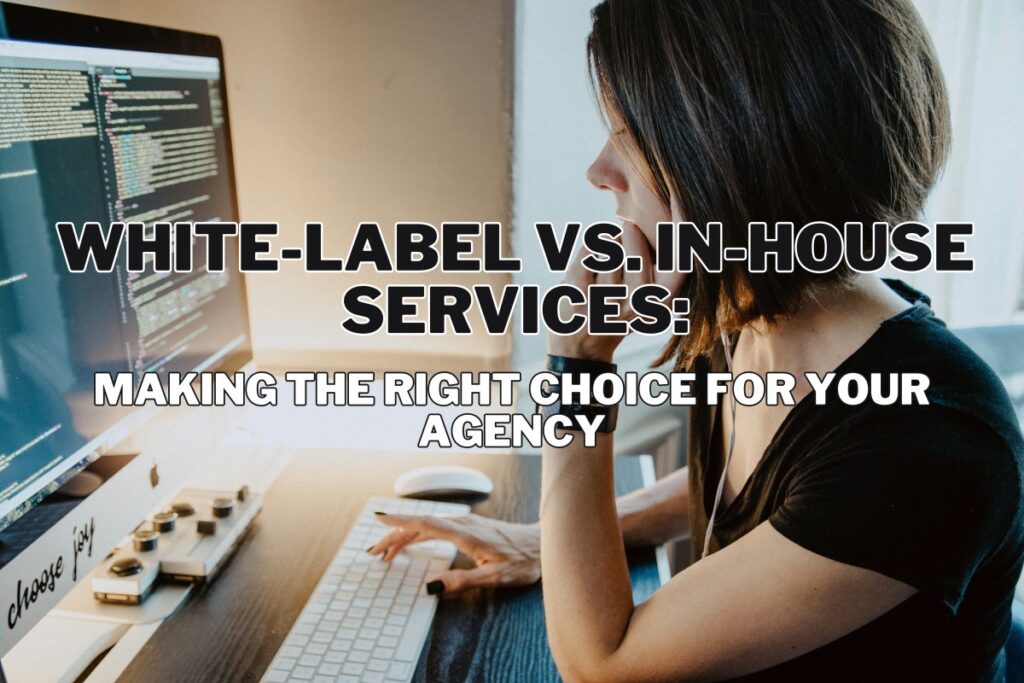
In today’s fast-paced digital marketing landscape, strategic decision-making is key for agency owners striving for growth and efficiency. One pivotal decision they face is choosing between white-label and in-house services.
Each approach offers unique advantages and drawbacks, making it crucial to understand the nuances to make informed choices that align with business goals and client needs.
Understanding White-Label Services
White-label services entail outsourcing non-core tasks to third-party providers while maintaining the agency’s branding.
This approach offers several advantages:
- Scalability:
Agencies can handle larger projects and clients without expanding internal resources, enabling them to accommodate growth efficiently. - Expertise Access: Access to specialized skills and technologies without extensive training or hiring allows agencies to deliver high-quality services to clients.
- Time Efficiency: By outsourcing non-core tasks, agencies can focus on core competencies and client relationships, enhancing overall productivity.
However, white-label services also come with their own set of challenges:
- Brand Dilution: If not seamlessly integrated, white label services may dilute agency brand identity, leading to confusion among clients.
- Dependency: Relying on third-party providers may pose challenges in quality control and client communication, affecting overall service delivery.
- Profit Margin Compression: Higher costs associated with outsourcing may impact profit margins if not managed effectively, necessitating careful financial planning.
Exploring In-House Services
In-house services involve developing internal capabilities to deliver services directly to clients, providing agencies with greater control and customization options.
The advantages include:
- Brand Control: Maintaining complete control over service quality, brand messaging, and client interactions fosters trust and consistency.
- Flexibility: Agencies can tailor services to meet specific client needs and adapt quickly to industry changes, enhancing agility and competitiveness.
- Long-term Investment: Building internal expertise and capabilities enables agencies to invest in sustainable growth and differentiation, setting them apart in the market.
However, in-house services also present challenges:
- Resource Intensiveness: Significant investment in hiring, training, and infrastructure development is required, which may strain resources, particularly for smaller agencies.
- Skill Gap Challenges: Accessing specialized skills or technologies may be limited compared to external providers, posing potential limitations in service delivery.
- Capacity Constraints: Limited scalability during periods of high demand or rapid growth may lead to bottlenecks and inefficiencies, hindering overall performance.
Making the Decision: Factors to Consider
When deciding between white-label and in-house services, several factors should be taken into account:
- Client Needs and Expectations: Align service delivery models with client preferences and industry trends to enhance client satisfaction and retention.
- Financial Considerations: Evaluate cost-effectiveness, profit margins, and long-term sustainability to ensure optimal resource allocation and financial stability.
- Growth Strategy: Assess scalability, agility, and competitive positioning within the market to identify opportunities for growth and differentiation.
- Risk Management: Mitigate risks associated with dependency, quality control, and market volatility to safeguard the agency’s reputation and stability.
Conclusion
Choosing between white-label and in-house services is crucial for digital marketing agency owners.
By weighing the pros and cons carefully and considering key factors such as client needs, financial considerations, growth strategy, and risk management, agencies can make informed decisions that drive efficiency, growth, and client satisfaction.
Adaptability and strategic partnerships are essential for success in the dynamic digital marketing landscape.
Whether opting for white-label or in-house services, agencies should continuously evaluate and refine their service delivery models to stay ahead of the curve and meet evolving client needs.
We invite digital marketing agency owners to share their experiences and insights in choosing between white-label and in-house services.
Join the conversation and engage with fellow industry professionals to exchange ideas, best practices, and valuable insights.
For agencies seeking guidance in optimizing their service delivery models, we offer resources and assistance to support your journey toward success.